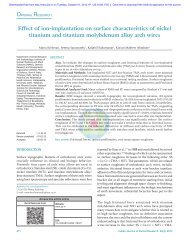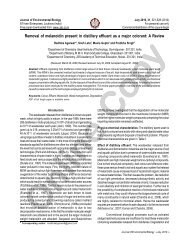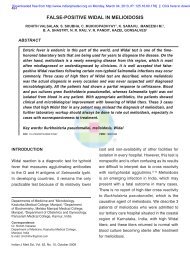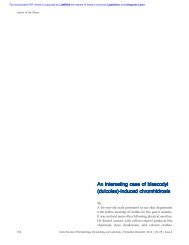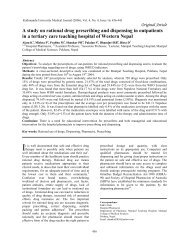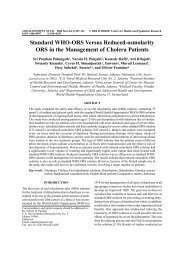Camponotus compressus - IMSEAR
Camponotus compressus - IMSEAR
Camponotus compressus - IMSEAR
You also want an ePaper? Increase the reach of your titles
YUMPU automatically turns print PDFs into web optimized ePapers that Google loves.
Short Communication<br />
Anaphylaxis due to Indian Black Ant Bite [<strong>Camponotus</strong><br />
<strong>compressus</strong>] and a Short Review of Literature<br />
ABSTRACT<br />
Anaphylaxis and death have been reported due to bite<br />
by many species of ants such as fire ant, carpenter ant,<br />
black ant (samsum), etc. But anaphylaxis due to the bite<br />
of the Common Indian Black Ant (<strong>Camponotus</strong><br />
<strong>compressus</strong>) is unusual, and has rarely been reported.<br />
We are reporting a case of anaphylaxis due to Indian<br />
black ant bite. Though the patient did not provide any<br />
previous history of a bite by this ant species, it could be<br />
presumed that he could have been bitten earlier.<br />
This case report emphasizes the need for precautions<br />
against bites by this species of ant which is widely regarded<br />
as relatively harmless.<br />
Key Words: Indian black ant; <strong>Camponotus</strong> <strong>compressus</strong>;<br />
Ant bite; Anaphylaxis<br />
Introduction<br />
Stinging or biting ants are now recognized as being of<br />
considerable public health significance in both temperate<br />
and tropical regions. Many species of ants produce<br />
venoms that contain powerful allergens and these secretions<br />
can cause severe local and systemic reactions.<br />
Anaphylaxis and death have been reported due to many<br />
species of ants such as fire ants, carpenter ants, black<br />
ants (samsum), etc. 1-3 But anaphylaxis due to the bite of<br />
the Common Indian Black Ant (<strong>Camponotus</strong><br />
<strong>compressus</strong>) is unusual, and rarely been reported.<br />
Sadananda Naik B * , Krishna Mohan Prabhu ** , Jyothi CS ***<br />
* (Author for correspondence): Physician, Alva’s Health Centre, Moodabidri-574227, Karnataka.<br />
Email: sadanandanaik2@gmail.com; sadanandanaik@sancharnet.in<br />
** General Surgeon, Prabhu General Hospital, Moodabidri-574227, Karnataka<br />
*** Dermatologist, Skin Care Clinic, Trade Centre, Moodabidri-574227, Karnataka<br />
43<br />
The Case: A 30 year-old man was brought to the hospital<br />
with a history of sudden collapse while talking over<br />
the phone. He complained of giddiness, itching all over<br />
the body, and swelling of lips and tongue. He appeared<br />
breathless. On enquiry, the patient recalled killing a black<br />
ant after it had bitten him on the palm a few minutes<br />
earlier. The patient did not provide any history of known<br />
allergy to ant bites. Later the ant was identified as Common<br />
Indian Black Ant (<strong>Camponotus</strong> <strong>compressus</strong>) by<br />
experts. This Indian black ant is known colloquially as<br />
“Kulpe”, an ant that is notorious for its painful bite in the<br />
coastal regions of India, where this case occurred.<br />
On examination, the patient was fully conscious and<br />
sweating. His blood pressure was 70/50 mm Hg, pulse<br />
110/minute, and respiratory rate 20/min. He had urticarial<br />
rash all over the body, and there was oedema of the lips<br />
and tongue. There was a small bite mark on the left palm<br />
with redness around it.<br />
Investigations: Routine laboratory investigations revealed<br />
the following: Hb 14gm%; total leucocyte count<br />
7700/cu mm; differential count - N68, L30, E2; RBS 128<br />
mg%; and blood urea 30 mg%. Serum electrolytes, renal<br />
parameters, and liver function tests were normal. Urine<br />
examination did not reveal any abnormal findings. We<br />
could not perform skin tests with Indian black ant extract,<br />
as it was not available.<br />
The patient was managed with IV normal saline,<br />
parenteral chlorpheneramine maleate, hydrocortisone,
44 JOURNAL OF THE INDIAN SOCIETY OF TOXICOLOGY (JIST) VOL 008 ISSUE 001 JAN-JUNE 2012<br />
adrenaline and nasal oxygen. He showed marked improvement<br />
in haemodynamic parameters in 4 to 6 hours<br />
and was discharged on the second day.<br />
Discussion<br />
The Common Indian Black Ant (<strong>Camponotus</strong><br />
<strong>compressus</strong>) is a species of formicine ant found in Asia.<br />
It is the most common black ant found in India (Fig 1),<br />
and is one of the most abundant and best known species.<br />
4 Usually, bites by these ants produce moderate to<br />
severe local pain lasting for a few minutes, and may be<br />
associated with mild local swelling and erythema. But<br />
anaphylaxis due to its bite, as seen in our case is rare<br />
and not reported so far. Though our patient did not provide<br />
any previous history of bites by this ant species, it<br />
can be presumed that he could been have been bitten<br />
earlier. Being a formicine ant, the Indian black ant produces<br />
cytotoxic venom that contains formic acid as the<br />
predominant venomous component, and it is present as a<br />
60% aqueous solution. Free amino acids and small peptides<br />
are the other constituents of the venom which are<br />
responsible for allergic reactions. Formic acid is the most<br />
corrosive and cytotoxic of the fatty acids (pKa 3.75) and<br />
this leads to dermal necrosis when it comes in contact<br />
with the skin in large amounts. Formicine ants lacerate<br />
the skin with their mandibles before ejecting formic acid<br />
into the wound site. This particular action of these insects<br />
leads to severe irritation of the injured area. The<br />
high concentrations of formic acid generated by these<br />
ants can result in pulmonary irritation as well. 5<br />
Fig 1: Indian Black Ant [<strong>Camponotus</strong> <strong>compressus</strong>]<br />
Stings and bites from ants are common. They often result<br />
in redness and swelling in the injured area. Some<br />
ants belonging to various species synthesize venoms<br />
which contain powerful allergens. These venoms can<br />
produce varying clinical manifestations ranging from<br />
mere local reaction to severe form of systemic manifestations.<br />
Severe reactions are characterized by symptoms<br />
such as wheezing, shortness of breath, chest tightness or<br />
pain, sensation of the throat closing, or difficulty speaking<br />
or swallowing, faintness, weakness, etc. The venom<br />
of imported fire ants [Solenopsis invicta] consists of<br />
aqueous and alkaloid fractions. This venom is 95% alkaloid,<br />
and the remaining aqueous fraction contains solubilized<br />
proteins. The alkaloid fraction of ant venom is not<br />
allergenic but the aqueous fraction is. The alkaloids (methyl-n-piperidines)<br />
produce postsynaptic neuromuscular<br />
blockade by inhibiting the Na+-K+-ATPase pump of<br />
muscle cell membrane. Clinically, it manifests as<br />
haemolytic, cytotoxic and neurologic reactions. Allergenic<br />
proteins comprise about 0.1% of the venom content and<br />
are responsible for the IgE-mediated systemic reactions;<br />
anaphylaxis is rare (
other small molecular weight proteins which are responsible<br />
for the severe allergy and anaphylaxis. 5<br />
Thus ant venoms are characterized by far greater structural<br />
diversity than other insects. A thorough knowledge<br />
of the ant venom and its toxicity will help the treating<br />
clinicians to improve the standard of care. The majority<br />
of ant bites are self-limiting events, which resolve in a<br />
few hours without specific treatment. However, prompt<br />
recognition and initiation of treatment is critical in successful<br />
management of anaphylactic reactions to ant<br />
bites. This case report emphasizes the need for precautions<br />
against bites by even relatively “harmless” species<br />
of ants.<br />
Acknowledgements<br />
The authors are grateful to Rotarian Jayaram Kotian for<br />
his help in identifying the ant species in this case, and for<br />
the review of literature.We are also thankful to Mr Ajay<br />
Narendra, Postdoctoral Fellow, Division of Evolution,<br />
Ecology & Genetics Research School of Biology, ARC<br />
Centre of Excellence in Vision Science, Australian National<br />
University, Canberra, Australia, for permitting us<br />
to use the picture of the ant.<br />
REFERENCES<br />
1. Vetter RS, Visscher PK. Bites and stings of medically important<br />
venomous arthropods. Int J Dermatol 1998;37(7):481–496.<br />
2. Stablein JJ, Lockey RF. Adverse reactions to ant stings. Clin Rev<br />
Allergy 1987;5(2):161–175.<br />
ANAPHYLAXIS DUE TO INDIAN BLACK ANT BITE AND A SHORT REVIEW OF LITERATURE<br />
45<br />
3. Al-Shahwan M, Al-Khenaizan S, Al-Khalifa M. Black (samsum)<br />
ant induced anaphylaxis in Saudi Arabia. (Pachycondyla<br />
sennaarensis) Saudi Med J 2006;27(11):1761–1763.<br />
4. Krishna Ayyar PN. The biology and economic status of the<br />
common black ant of South India - <strong>Camponotus</strong> (Tanaemyrmex)<br />
<strong>compressus</strong>. Bull Entomol Res 1935;26:575–585.<br />
5. Blum MS. Ant venoms: Chemical and pharmacological properties<br />
Toxin Rev 1992;11(2):115–1164.<br />
6. Stafford CT. Hypersensitivity to fire ant venom. Ann Allergy<br />
Asthma Immunol 1996;77(2):87–95.<br />
7. Freeman TM. Imported fire ants: The ants from hell! Allergy<br />
Proc 1994;15(1):11–15.<br />
8. Triplett RF. The imported fire ant: Health hazard or nuisance?<br />
South Med J 1976;69:258–259.<br />
9. Lawrence RS, KeiI JE, Brown LL, et al. The imported fire ant: A<br />
newly recognized problem in South Carolina. J SC Med Assoc<br />
1973;69:319–321.<br />
10. Klotz JH, deShazo RD, Pinnas JL, Frishman AM, Schmidt JO,<br />
Suiter DR, et al. Adverse reactions to ants other than imported<br />
fire ants. Ann Allergy Asthma Immunol 2005;95(5):418–425.<br />
11. Wiese MD, Brown SG, Chataway TK, Davies NW, Milne RW,<br />
Aulfrey SJ, Heddle RJ. Myrmecia pilosula (Jack Jumper) ant<br />
venom: Identification of allergens and revised nomenclature. Allergy<br />
2007;62(4):437–443.



